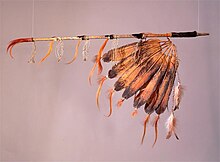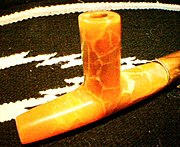Ceremonial pipe

A ceremonial pipe is a particular type of
Use in ceremonies
Although often called "peace pipes" by Europeans (and, specifically, calumet de paix, by the French[1]), the smoking of a ceremonial pipe to seal a peace treaty is only one use of a ceremonial smoking pipe, by only some of the nations that utilize them.
Various types of ceremonial pipes have been used by different
During his travels down the
In ceremonial usage, the smoke is generally believed to carry prayers to the attention of the Creator or other powerful spirits. Lakota tradition tells that White Buffalo Calf Woman brought the Chanunpa (Lakota sacred pipe) to the people, and instructed them in its symbolism and ceremonies.[4] Many Native American cultures still practice these ceremonies.
According to oral traditions, and as demonstrated by pre-contact pipes held in museums and tribal and private holdings, some ceremonial pipes are adorned with feathers, fur, animal or human hair, beadwork, quills, carvings or other items having significance for the owner. Other pipes are very simple. Many are not kept by an individual, but are instead held collectively by a medicine society or similar indigenous ceremonial organization.
Varieties and terminology
Indigenous peoples of the Americas who use ceremonial pipes have names for them in each culture's indigenous language. There is no single word for all ceremonial pipes across the hundreds of diverse Native cultures.
The Lakota sacred pipe is called a chanupa, also spelled chanunpa or c'anupa.[4]
In some historical sources written by colonists, a ceremonial pipe is referred to as a calumet (kal-yə-ˌmet, -mət). Calumet is a
Materials
Tobacco, Nicotiana rustica,[13] was originally used primarily by eastern tribes, but western tribes often mixed it with other herbs, barks, and plant matter, in a preparation commonly known as kinnikinnick.[14]
One material used for ceremonial pipe bowls in the
Pipestone varieties

This section needs additional citations for verification. (July 2015) |

A number of Indigenous North American cultures make and use ceremonial pipes. However, there are also Native American cultures that do not have a ceremonial smoking tradition, but make pipes for social smoking only. The types of materials used vary by community and locality. Some of the known types of pipe stone and pipe materials are:
- Clay
- The Cherokee and Chickasaw both fashion pipes made from fired clay, however these are only used for social smoking. They use small reed cane pipestems made from river cane. These pipes are made from aged river clay hardened in a hot fire.
- Red pipestone
- Great Basin Tribes. The stone can be found in Minnesota (Pipestone), and Utah (Delta, Uinta). Sacred pipestone comes from Pipestone, Minnesota. The quarry is located just north of the town at the Pipestone National Monument. Today only Native Americans are allowed to quarry the pipestone from this quarry. The pipestone from this quarry is considered the softest stone available.[citation needed]
- Blue pipestone
- is used predominantly by the Plains Tribes for certain types of ceremonial pipes. Deposits of the stone are found in South Dakota.
- Bluestone
- a hard, greenish-blue quartzite stone from the southern Appalachian Mountains. After being worked, it takes on a decidedly greenish cast. This stone has been used by several Eastern Woodlands tribes for pipemaking. Several ancient Mississippian culture bluestone pipes have been excavated.
- Salmon alabaster
- The Uncompahgre Ute People make ceremonial pipes from salmon alabaster mined in central Colorado.
- Green pipestone
- A white on green marbled , Ute, and Plains Tribes for personal and ceremonial pipes. This stone is also used to carve sacred effigies and religious items.
- Black pipestone (South Dakota)
- a soft, brittle, white on black marbled pipestone found in South Dakota and used by some of the Plains Tribes for certain types of ceremonial pipes.
- Black pipestone (Uinta)
- an extremely hard black quartzite slate which has undergone metamorphic compression and is found in the southeastern drainage of the Uinta Mountains in Utah and Colorado. This stone has been used by the Great Basin Tribes for war clubs and pipes that are jet black with a high gloss when polished. Stones which have tumbled down creeks and drainages are always selected, since these stones typically contained no cracks or defects.
Traditional pipemaking tools

One traditional method of manufacture is the use of
See also
References
Notes
- OCLC 1083889360.
- ^ a b Leavelle, Tracy Neal (2012) The Catholic Calumet: Colonial Conversions in French and Indian North America. University of Pennsylvania Press.
- ^ a b c Moore, Powell A. (1959). The Calumet Region: Indiana's Last Frontier. Indiana Historical Bureau. Retrieved 20 August 2015.
- ^ Indian Country Today Media Network
- ^ CNRTL site etymology of calumet
- ^ Rowland, Dunbar (1907)
- ^ Calumet or "Peace-pipe" of the Indians, Handbook of American Indians North of Mexico, Bureau of American Ethnology, 1907
- ^ The word comes from Late Latin calamellus. The Northern Norman dialect retains the group /ca/, when it turns into /ʃa/ (cha-) in Common French and it retains the suffix -el, when it has turned into -eau in Common French. The fall of the final /l/ is specific for the Cauchois dialect, which explains the later confusion with another suffix -et, pronounced the same way [e].
- ^ CNRTL
- ^ T.F. Hoad, English Etymology, Oxford University Press, 1993, p. 59
- ^ Calumet River-Frontal Lake Michigan Archived 2015-10-21 at the Wayback Machine, Watershed Central Wiki, U.S. EPA, quoting from the "City of Chicago Calumet Land Use Plan"
- ISBN 9780295994284.
- ^ The Native American Chanunpa, the Sacred Pipe Archived 2012-12-21 at the Wayback Machine Archived 2012-12-21 at the Wayback Machine, Barefoot's World
- ^ Charles L. Cutler. Tracks that speak: the legacy of Native American words in North American culture. Houghton Mifflin Harcourt (Boston : 2002).
- ^ "Catlinite, Calumet Pipes and Pipestone National Monument". Maps, Material, Culture, and Memory: On the Trail of the Ioway. University of Iowa. Archived from the original on 3 July 2015. Retrieved 20 August 2015.
- ^ "Pipestone National Monument". National Park Service. Retrieved 19 May 2012.
- ^ Geologic Formations, Pipestone National Monument, Minnesota, National Park Service
- ^ Paul S. Martin, "The bow-drill in North America." American anthropologist 36.1 (1934): 94-97. online
- This article incorporates text from a publication now in the public domain: Chisholm, Hugh, ed. (1911). "Calumet". Encyclopædia Britannica (11th ed.). Cambridge University Press.
Further reading
- Brown, Ian W. "The calumet ceremony in the southeast and its archaeological manifestations." American Antiquity 54.2 (1989): 311-331.
- Cessford, Craig. "The archaeology of the clay pipe and the study of smoking." Assemblage 6 (2001): 84-112. online
- Cutler, Charles L. Tracks that speak: the legacy of Native American words in North American culture. (Boston: Houghton Mifflin Harcourt. 2002).
- Haberman, Thomas W. "Evidence for aboriginal tobaccos in eastern North America." American Antiquity 49.2 (1984): 269-287.
- Hall, Robert L. "Calumet Ceremonialism, Mourning Ritual, and Mechanisms of Inter-tribal Trade." in Mirror and Metaphor: Material and Social Constructions of Reality (1987): 29-43.
- Hays, Charles F. III, ed. Proceedings of the 1989 Smoking Pipe Conference: Selected Papers (Research Division of the Rochester Museum and Science Center, 1992).
- Higgins, David A. "Clay tobacco pipes: a valuable commodity." International Journal of Nautical Archaeology 24.1 (1995): 47-52. online
- Springer, James Warren. "An ethnohistoric study of the smoking complex in eastern North America." Ethnohistory (1981): 217-235. online
- Winter, Joseph C., ed. Tobacco Use by Native North Americans: Sacred Smoke and Silent Killer (University of Oklahoma Press, 2000).
External links
- Society for Clay Pipe Research, founded 1983
- Pipestone County Museum – History
- Symbol and Substance in American Indian Art, an exhibition catalog from The Metropolitan Museum of Art (fully available online as PDF), which contains material on calumets
